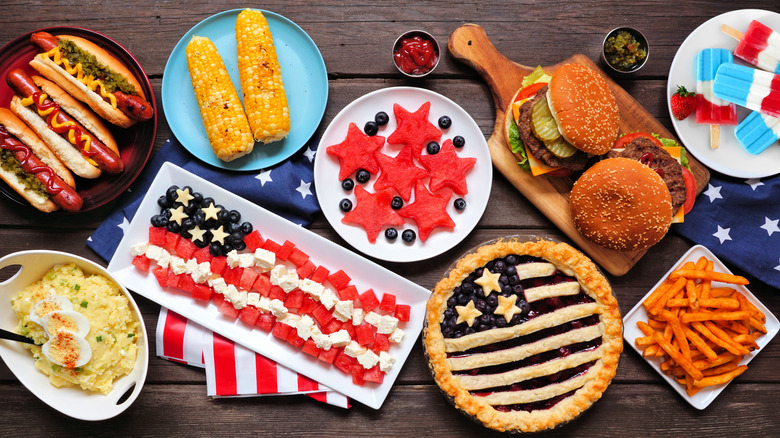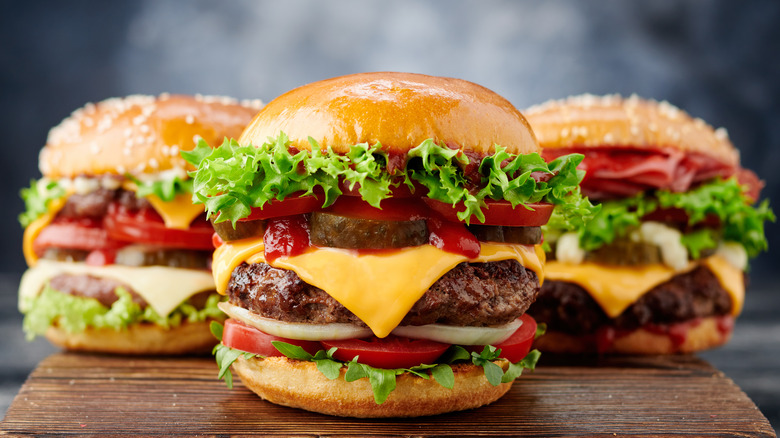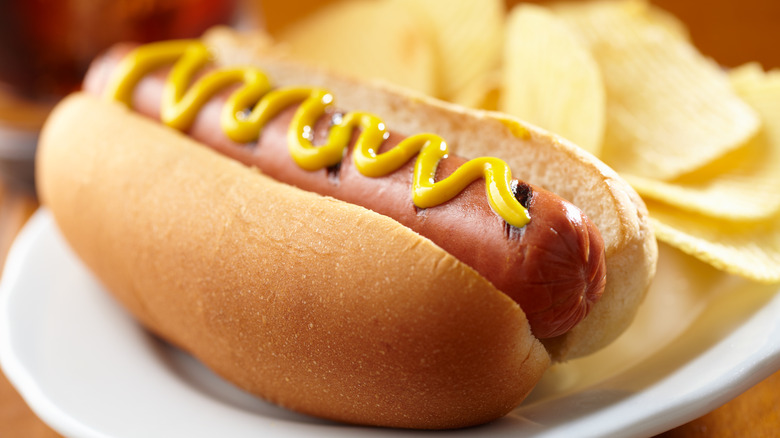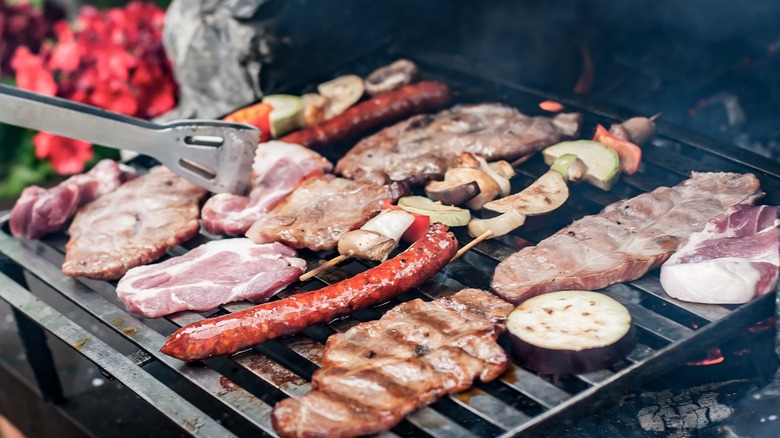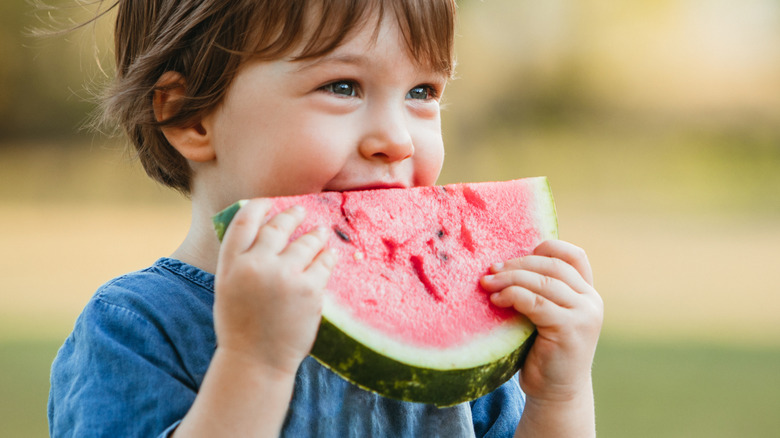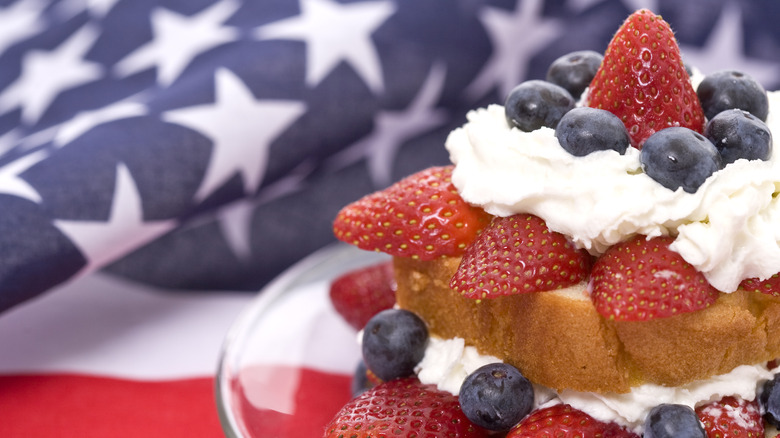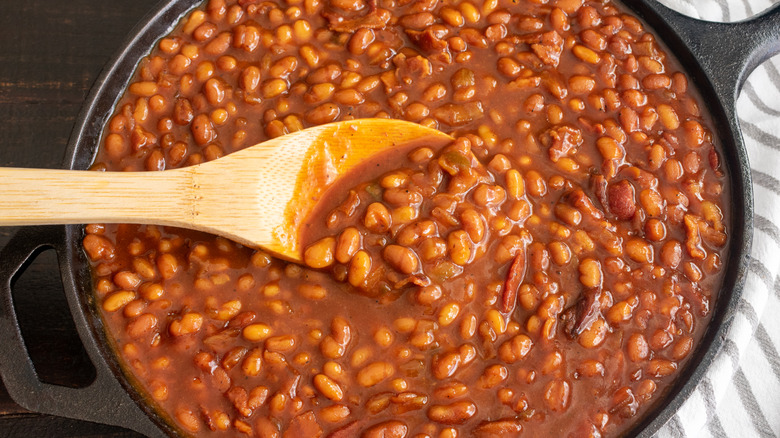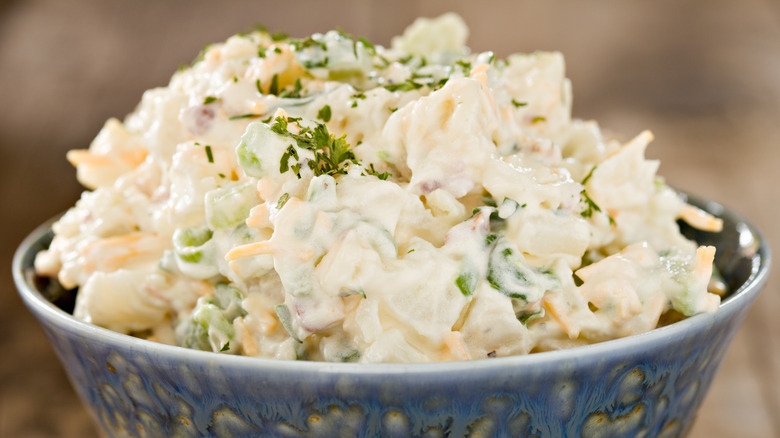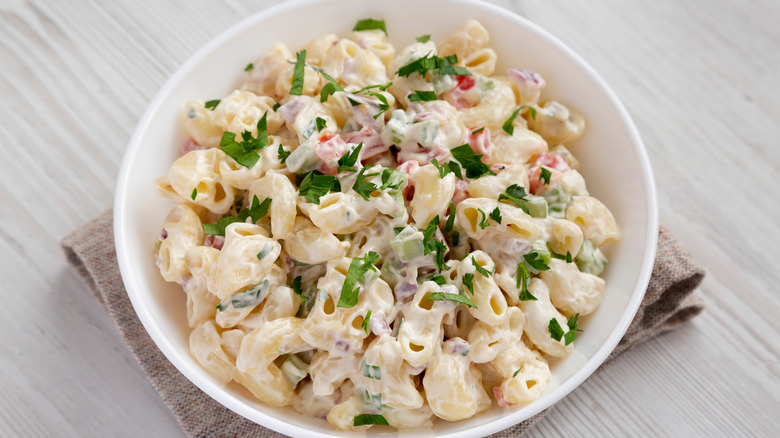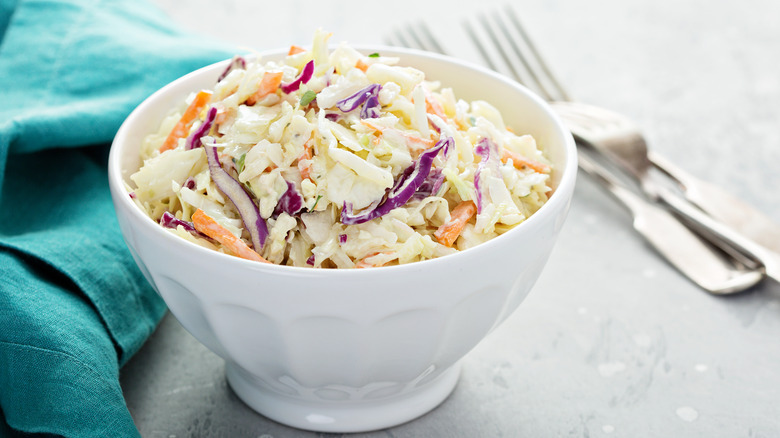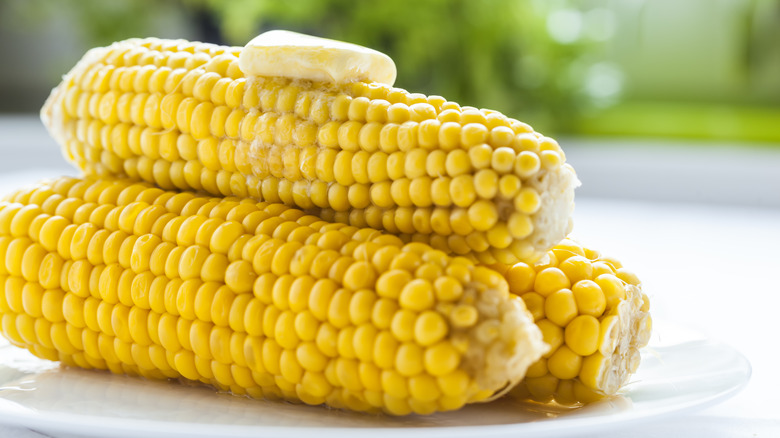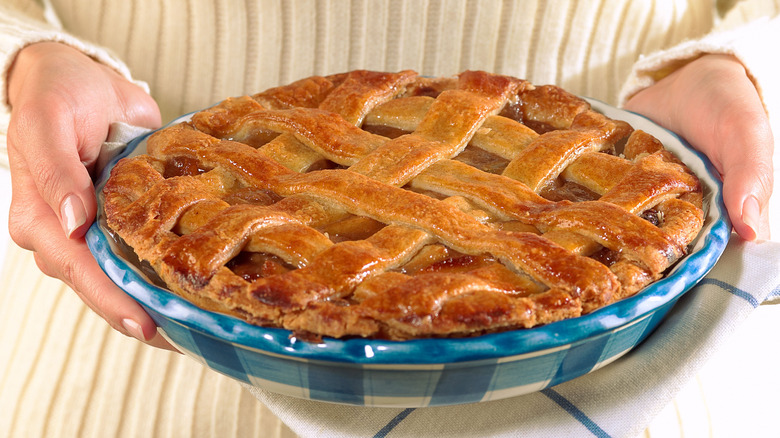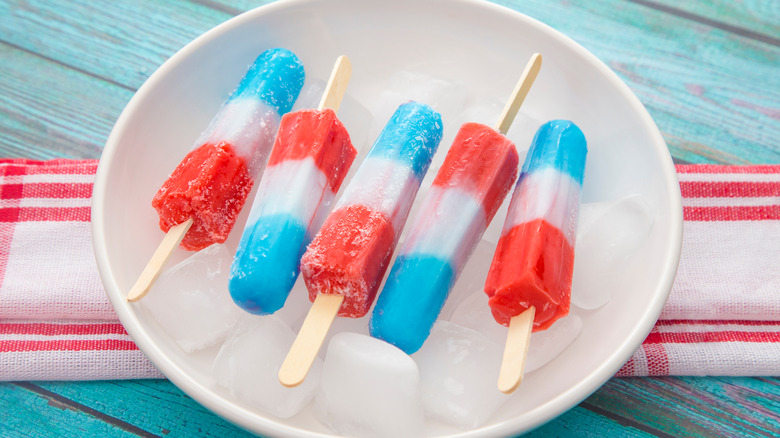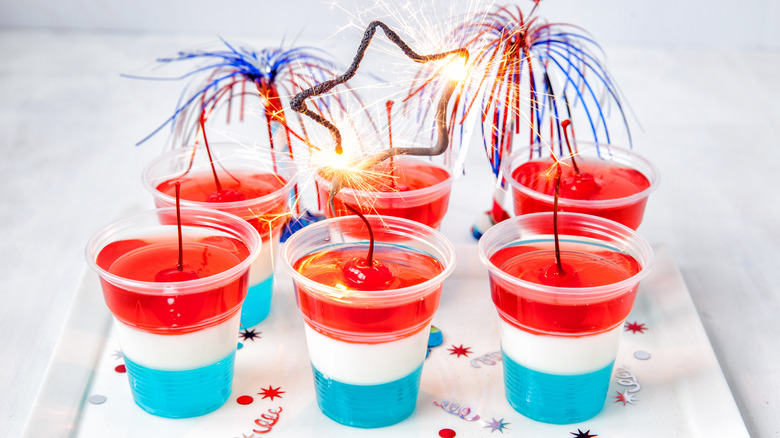13 Traditional 4th Of July Foods And Where They Come From
For most Americans, the 4th of July is a day to let loose and enjoy summer with an array of block parties, pool parties, beach parties, and simply gathering with friends and family in backyards. Of course, for many, the main attractions include writing your name in the air with sparklers and oohing and ahhing over fireworks, whether they fly high in the sky or light up the driveway. But we would like to remind you of something else to look forward to on this day of celebration. We're talking about the food!
During the summer, the lure of the outdoor grill is too much to pass up, and some amazing things can be cooked there whether you prefer gas or charcoal. But where did those grilled goodies come from? Why do we associate them with summer parties? And who decided that all of those sides, desserts, and other treats loading down the picnic table were also just right for the 4th of July?
The United States is largely a country with contribution from many immigrants, meaning that people from all over the world have brought their summer celebration traditions and favorite foods with them. Despite these different roots, many have come together into our shared American culture. This 4th, we'd like to take a moment to look at where our food traditions came from. We think it will give us all something extra to celebrate.
Hamburgers
If you want proof of how much Americans love to chow down on burgers, then look no further than the plethora of popular burger chains that stretch from sea to shining sea. But burgers were made for grilling, and what's more satisfying than biting into a juicy burger fresh off the gridiron with genuine, parallel grill marks on both sides?
It's pretty common knowledge that hamburgers are named after the German city where they are said to have originated: Hamburg. No one can definitively say if that is true, but we do know that German immigrants brought so-called Hamburg steaks with them to the U.S. When people began to sell them from food carts, it soon became apparent that this style of serving the steaks was a real mess. Sandwiching them between two slices of bread and serving them as a sandwich proved to be American innovation at its finest.
Hot dogs
There are a lot of urban legends out there surrounding hot dogs, including their origins. Did they come from Frankfurt, Germany, hence the name Frankfurter? Or perhaps they were born in Vienna, Austria (Wien in German), where we supposedly get the word wiener. We know that sausages, defined as minced meat that's been seasoned and stuffed into a casing, were consumed even in ancient times. In more recent history, the hamburger, frankfurters, and wieners were most likely brought to the U.S. by 19th-century German immigrants.
As for nestling the sausage in a bun, people continue to argue as to whether or not this was an American innovation or a longstanding German tradition. However you slice it, the hot dog quickly became beloved by Americans. It's now a staple at Coney Island restaurants and sports stadiums across the nation, while many might argue that no 4th of July barbecue would be complete without a few hot dogs on the grill.
Barbecue
It turns out that Americans love to barbecue meat, as any hungry 4th of July partygoer or grill-bound cook will tell you.
The word barbecue comes from the Arawak people indigenous to Haiti, who originally used the word "barbakoa" to mean the structure built to cook meat for a long time over a smoky open fire. This term evolved to mean both the style of cooking and the meat cooked in this manner. While most people today barbecue only parts of an animal, it used to be more common to cook the animal whole in a large pit (hence the long history of pit barbecue). As you can imagine, that's a lot of meat and a great way to feed a large group of people who have gathered to, let's say, celebrate the independence of their country. Today's pitmasters carry on a long and proud tradition of feeding those hungry crowds.
Watermelon
Let's move away from meat for a little bit and talk about one of summer's sweetest treats: watermelon. Watermelon is, of course, mostly composed of water, which makes indulging in a few slices while spending time in the sun a handy way to stay hydrated. It's also a good source of several vitamins and minerals while remaining low in calories and offering a bit of fiber.
Watermelon is an ancient plant that spread fairly quickly across the globe once trade networks sprang up. The fruit was likely introduced to the Americans by European explorers and colonizers. The earliest recorded mention of it in North America has the plant growing in Florida in 1576 and Massachusetts in 1629. American Indian tribes also began to grow the fruit across the continent. Founding Father Thomas Jefferson was a watermelon fan and had them grown at his Virginia plantation.
With a pedigree like that, how can we not raise a slice of juicy, pink watermelon in tribute on the 4th of July?
Berries
People enjoy creating foods with a theme. Consider how pumpkin flavors and colors pop up everywhere in October for Halloween. During December, things turn red and green for Christmas, while Hanukkah celebrations sport blue, white, and silver colors. What do we do on the 4th of July? Turn everything red, white, and blue, of course!
Thankfully, we don't need to resort to food dyes to achieve this patriotic color scheme. That's because summer is berry-picking time in many parts of the U.S., and Mother Nature helpfully provides us with some delicious and nutritious red and blue berries. Strawberries and blueberries are particularly popular amongst cooks who strive for a red, white, and blue theme, but there are also blackberries and raspberries as less-bright alternatives. The white can come from whipped cream, cream cheese, or white frosting.
Strawberry shortcakes, blueberry crumbles, and homemade syrups are all wonderful ways to enjoy these summer sweets. Or why not craft a mixed berry ice cream sundae? Or a colorful spritzer to drink on a hot day? This is one area where you can let your imagination run wild!
Baked beans
Not everything Mother Nature provides is as sweet as a berry. Take beans, for example, though they're still pretty tasty and offer a good dose of fiber and protein. Bonus: July is Baked Beans Month, which is fitting as this dish has been with Americans for a long time. Some say that indigenous people introduced baked beans to English colonists, while others maintain that recipes were brought from North Africa to Europe first and modified along the way. What we know as baked beans today is most likely a descendant of all of the above dishes.
Exact recipes for baked beans vary not only by region but by family and personal preference. Some call for salted pork while others forgo meat entirely. To achieve that savory-sweet flavor, employ maple syrup or brown sugar. Some people even include barbecue sauce in their baked beans. However you enjoy them, baked beans are clearly an American dish with a long history that has every right to be on a 4th of July table.
Potato salad
Speaking of adjusting a recipe to suit personal taste, enter potato salad. The only thing that different potato salad styles have in common is potato!
The earliest known takes on potato salad were brought from the Americas to Europe by Spanish colonizers in the 1500s. A few centuries later, it was carried to the U.S. by German immigrants, who dressed cooked potatoes in a blend of oil, vinegar, and herbs. German potato salad is also usually served warm. Mayonnaise, now a common component of the dish, didn't become a popular dressing for potato salad until the early 20th century. This type of potato salad, which has arguably become more popular in American cuisine than its acidic German ancestor, is served chilled.
Potato salad is a savory side dish that is easy to make and goes great with burgers, hot dogs, and other backyard barbecue staples. And as a native tuber that has been embraced by people of all cultures, it makes a fitting symbol during a 4th of July celebration.
Pasta salad
Similar to potato salad, pasta salad is a popular picnic staple that can be dressed in an oil and vinegar blend or with mayonnaise. Just about any fork-ready small noodle goes here, from penne to bowtie. One particularly popular variety is macaroni salad, which mixes elbow noodles with mayonnaise. Beyond those two ingredients, the sky's the limit when it comes to pasta salad. Do you like cheese? Toss in some cubes. Celery? Green peppers? Chop it up and toss that in, too. You can even purchase red, white, and blue noodles for an overtly patriotic theme.
Given that there is so much variety in macaroni salad recipes, no one knows where this form of pasta salad originated. Macaroni salad seems to have been an American innovation, however and may have been invented as a variation on potato salad. A 1930 recipe for mock potato salad calls for both elbow pasta and potatoes as well as the now-familiar diced onion, bell pepper, and boiled egg garnish. Could this be a marriage of traditional dishes brought to the U.S. by German and Italian immigrants? That sounds pretty American to us.
Coleslaw
Boy, many Americans sure do like to mix things with mayonnaise! When talking about mayonnaise-based side dishes, how can we forget to mention coleslaw? The word coleslaw comes from the Dutch koolsla, or cabbage salad. But we can all agree that coleslaw has grown well beyond its cabbage roots, as ingredients like grated carrots and broccoli are common additions to slaw these days.
Cabbage salads have been around since at least ancient Roman times. Coleslaw was brought to American shores well before the states claimed independence from England, as Dutch colonists were mixing it up when New York was still New Netherland. The first use of the word coleslaw was in 1794. Before the invention of mayonnaise, a dressing of melted butter, oil, and vinegar was used to make the dish.
Like its sibling salads, coleslaw is a relatively blank slate that can be jazzed up with the addition of fruit, herbs, spices, and other vegetables. There's no reason it can't continue to evolve with each new 4th of July party.
Corn on the cob
A lot of now commonly eaten foods are native to the Americas, but corn (also known as maize) might be the continent's biggest success story. According to the United States Department of Agriculture, the U.S. grew 15.1 billion bushels of corn in 2021 alone.
It's understandable why this is a popular cookout food. Corn is pretty easy to cook, even when the kernels are left on the cob. All you have to do is simply boil it, roast it, or place it on the grill next to the hamburgers and hot dogs. When picked at the right time, many varieties of corn are naturally sweet and may be eaten as-is. Some argue that smothering a freshly-cooked cob in butter or a little salt and pepper can enhance the flavor. In Mexico, the land of corn's birth, it is common to roll ears of cooked corn in mayonnaise, chili powder, crumbled cotija cheese, and other ingredients of choice to create the delicious treat known as elotes.
Kernels of corn can, of course, be removed from the cob and eaten alone or used in a corn salad like esquites, but eating it straight from the source is a longstanding summer staple.
Pie
What better way to put the fruits and berries of summer to good use than to bake them into a pie? And we can't forget that tastiest of American symbols: apple pie. English settlers learned to make pie from earlier Dutch settlers, which set them apart from their cousins in the home country who were more likely to make puddings or shortbread. The very first American cookbook, "American Cookery," was published in 1796 and included recipes for both apple and pumpkin pie.
Over the generations, this dish became so classic that, during World War II, when U.S. soldiers were asked by the press what they were fighting for, many reportedly answered that they were doing so "for mom and apple pie." This is why you can feel proud presenting an apple pie at the center of your dessert table, perhaps alongside a blueberry and strawberry pie to show off that red, white, and blue theme. And what goes better with pie than a scoop of vanilla ice cream?
Popsicles
Popsicles are a great way to cool down on a hot day as well as stay hydrated amid a busy cookout. The red, white, and blue variety are tailormade for the 4th of July. They're so popular that there is more than one tri-colored patriotic pop to be had.
Cherry, lime, and blue raspberry-flavored Bomb Pops were created in Kansas City, Missouri in 1955 by D.S. "Doc" Abernathy and James S. Merritt. The Popsicle brand joined in when it released its tricolored Firecrackers in 1989. Both frozen treats are shaped like a missile.
The Bomb Pop brand now offers several different flavors including watermelon, banana fudge, and Candy Clash in the same iconic shape — though the original red, white, and blue variety remains an Independence Day favorite. With a little help from fruit juice or just a few drops of food coloring, as well as popsicle molds, it's easy to create your own patriotic themed popsicles in whatever flavors you like best.
Jell-O
Whether it's the American-made Jell-O brand or a generic alternative, Americans have been using flavored gelatin to make all kinds of desserts for decades. Jell-O comes in practically every color of the rainbow, so it is easy to mix and match them to suit a holiday's theme. For your backyard barbecue, you could go for simple layered squares of red, white, and blue Jell-O, but this isn't the only gelatin dessert to pop up at picnics and barbecues. Though they were most popular in the mid-20th century, Jell-O salads sometimes still make an appearance at American gatherings. Marshmallows, nuts, shredded carrots, and pieces of fruit are popular additions to a Jell-O salad.
Blue and red Jell-O is a cinch to make, but what about the white? This can come from the simple addition of whipped cream or cream cheese. Otherwise, you can mix milk with clear gelatin to turn it white.
